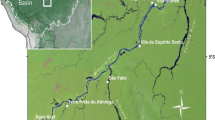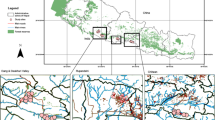Abstract
Useful Species Richness, Proportion of Exotic Species, and Market Orientation on Amazonian Dark Earths and Oxisols Anthropogenic soils of Amazonia, known as Amazonian Dark Earths (ADE), are environments with elevated soil fertility that can produce crops that otherwise yield poorly on the leached and highly acidic Oxisols that dominate much of the basin. While ADE sites near urban centers often attract commercial horticultural production of nutrient–demanding exotics, these soils are also considered possibly unique reservoirs of endemic agrobiodiversity because of their relationship to pre–Columbian indigenous occupation. Through botanical surveys and interviews with smallholder farmers, this study compared useful species richness, proportion of exotic species, and market orientation of farms situated on ADE and non–anthropogenic Oxisols in the municipality of Borba in Central Brazilian Amazonia. Species richness was similar on Amazonian Dark Earth and Oxisol farms (19.6 spp vs. 18.3 spp); however, ADE farms showed significantly higher proportions of exotic species (39% vs. 26%; p = 0.025). Furthermore, ADE farms in Borba demonstrated significantly higher market orientation (61.0% vs. 47.3%; p = 0.028), likely a result of the advantage of Amazonian Dark Earths for production of crops that are nutrient–demanding or pH–sensitive crops that have higher values in the nearby regional market of Manaus.
Riqueza de espécies úteis, proporção de espécies exóticas e orientação para o mercado em sítios sobre Terra Preta de Índio e Latossolos em Borba, Amazonas, Brasil Solos antrópicos da Amazônia, conhecidos como terra preta de índio (ADE), são ambientes de alta fertilidade capazes de sustentar a produção de cultivos que não se desenvolvem bem nos latossolos ácidos e pobres da bacia Amazônica. Sítios em ADE próximos a centros urbanos são frequentemente utilizados para a produção comercial de cultivos exóticos, embora esses solos sejam também considerados reservatórios de agrobiodiversidade endêmica devido à sua relação com a ocupação indígena na época Pré–colombiana. Utilizando dados de inventários florísticos e de entrevistas com pequenos agricultores, esse estudo comparou a riqueza de espécies úteis, a proporção de espécies exóticas e a orientação para o mercado em sítios sobre ADE e sobre latossolos no município de Borba, Amazonas, Brasil. A riqueza de espécies é similar em ADE e em latossolos (19,6 spp. vs. 18,3 spp.), entretanto os agricultores manejam em ADE uma maior proporção de espécies exóticas (39% vs. 26%; p = 0,025). Além disso, os sítios em ADE têm maior orientação para o mercado (61% vs. 47,3%), o que está provavelmente relacionado à vantagem que ADE oferece para a produção de cultivos exigentes em nutrientes ou sensíveis à acidez do solo, que são mais valorizados no mercado regional de Manaus.

Similar content being viewed by others
Literature Cited
Almeida, A. A. F. and R. R. Valle. 2007. Ecophysiology of the cacao tree. Brazilian Journal of Plant Physiology 19(4):425–448.
Balée, W. 1994. Footprints of the forest: Ka’apor ethnobotany—The historical ecology of plant utilization by an Amazonian people. Columbia University Press, New York.
Berlin, B. 1992. Ethnobiological classification: Principles of categorization of plants and animals in traditional societies. Princeton University Press, Princeton, New Jersey.
Cavalcante, P. B. 1991. Frutas comestíveis da Amazônia, 5th edition. Edições CEJUP, Belém, Brazil.
Clement, C. R. 1999. 1492 and the loss of Amazonian crop genetic resources. I. The relation between domestication and human population decline. Economic Botany 53(2):188–202.
———, J. M. McCann, and N. J. H. Smith. 2003. Agrobiodiversity in Amazonia and its relationship with Dark Earths. Pages 159–178 in J. Lehmann, D. C. Kern, B. Glaser, and W. I. Woods, eds., Amazonian Dark Earths: Origin, properties, management. Kluwer Academic Publishers, Dordrecht, The Netherlands.
Coomes, O. T. and N. Ban. 2004. Home gardens in Amazonian Peru: Diversity and exchange of planting material. Geographical Review 94(3):348–367.
——— and G. J. Burt. 1997. Indigenous market–oriented agroforestry: Dissecting local diversity in western Amazonia. Agroforestry Systems 27:27–44.
Cromwell, E. and S. van Oosterhout. 1999. On–farm conservation of crop diversity: Policy and institutional lessons from Zimbabwe. Pages 217–238 in S. Brush, ed., Genes in the field: On–farm conservation of crop diversity. Lewis Publishers, Boca Raton, Florida.
Fearnside, P. and P. M. L. Graça. 2006. BR–319: Brazil’s Manaus–Porto Velho highway and the potential impact of linking the arc of deforestation to Central Amazonia. Environmental Management 38:706–716.
Fraser, J. A. 2010. Amazonian Dark Earths and Caboclo subsistence on the middle Madeira River, Brazil. Ph.D. dissertation, Department of Anthropology, University of Sussex, United Kingdom.
———, T. Cardoso, A. Junqueira, N. Falcão, and C. R. Clement. 2009. Historical ecology and Dark Earths in whitewater and blackwater landscapes: Comparing the Middle Madeira and Lower Negro Rivers. Pages 229–264 in W. I. Woods, W. G. Texeira, J. Lehmann, C. Steiner, A. M. G. A. WinklerPrins, and L. Rebellato, eds., Amazonian Dark Earths: Wim Sombroek’s Vision. Springer, Berlin.
——— and C. R. Clement. 2008. Dark Earths and manioc cultivation in Central Amazonia: A window on pre–Columbian agricultural systems? Boletim do Museu Paraense Emilio Goeldi 3(2):175–194.
German, L. A. 2003. Ethnoscientific understandings of Amazonian Dark Earths. Pages 179–201 in J. Lehmann, D. C. Kern, B. Glaser, and W. I. Woods, eds., Amazonian Dark Earths: Origin, properties, management. Kluwer Academic Publishers, Dordrecht, The Netherlands.
Glaser, B., G. Guggenberger, and W. Zech. 2004. Identifying the pre–Columbian anthropogenic input on present soil properties of Amazonian Dark Earth (Terra Preta). Pages 145–158 in B. Glaser and W. I. Woods, eds., Amazonian Dark Earth: Explorations in space and time. Springer–Verlag, Berlin.
———, G. Guggenberger, W. Zech, and M. L. Ruivo. 2003. Soil organic matter stability in Amazonian Dark Earths. Pages 141–158 in J. Lehmann, D. C. Kern, B. Glaser, and W. I. Woods, eds., Amazonian Dark Earths: Origin, properties, management. Kluwer Academic Publishers, Dordrecht, The Netherlands.
———, L. Haumaier, G. Guggenberger, and W. Zech. 2001. The ‘Terra Preta’ phenomenon: A model for sustainable agriculture in the humid tropics. Naturwissenschaften 88:37–41.
Harris, M. 2000. Life on the Amazon: Anthropology of a Brazilian peasant village. British Academy, London.
Hilbert, P. P. 1968. Archaeologische Untersuchungen am Mittleren Amazonas: Beitrage zur Vorgeschichte des sudamerkanischen Tieflandes. Dietrich Reimer Verlag, Berlin.
Hiraoka, M., S. Yamamoto, E. Matsumoto, S. Nakamura, I. C. Falesi, and A. R. C. Baena. 2003. Contemporary use and management of Amazonian Dark Earths. Pages 395–396 in J. Lehmann, D. C. Kern, B. Glaser, and W. I. Woods, eds., Amazonian Dark Earths: Origin, properties, management. Kluwer Academic Publishers, Dordrecht, The Netherlands.
IBGE. 2005. Brazilian Institute of Geography and Statistics. Instituto Brasileiro de Geografia e Estatística, Rio de Janeiro. http://www.ibge.br.gov (15 November 2007).
Junqueira, A. B., G. H. Shepard, and C. R. Clement. 2010. Secondary forests on anthropogenic soils conserve agrobiodiversity. Biodiversity and Conservation 19:1933–1961.
Kehlenbeck, K. and B. L. Maass. 2004. Crop diversity and classification of homegardens in Central Sulawesi, Indonesia. Agroforestry Systems 63:53–62.
Lamont, S. R., W. H. Eshbaugh, and A. M. Greenberg. 1999. Species composition, diversity, and use of homegardens among three Amazonian villages. Economic Botany 53(3):312–126.
Lehmann, J., J. P. da Silva, Jr., M. Rondon, M. da S. Cravo, J. Greenwood, T. Nehls, C. Steiner, and B. Glaser. 2002. Slash–and–char: A feasible alternative for soil fertility management in the Central Amazon? Proceedings of the 17th World Congress of Soil Science, CD–ROM Paper no. 449, 1–12. Bangkok: WCSS.
Major, J., C. R. Clement, and A. DiTommaso. 2005. Influence of market orientation on food plant diversity of farms located on Amazonian Dark Earth in the region of Manaus, Amazonas, Brazil. Economic Botany 59(1):77–86.
Mann, C. C. 2008. Ancient earthmovers of the Amazon. Science 581(3293):1148–1152.
Marris, E. 2006. Putting the carbon back: Black is the new green. Nature 442:624–626.
McCann, J. M. 1999. Before 1492: The making of the pre–Columbian landscape, Part 2: The vegetation, and implications for restoration for 2000 and beyond. Ecological Restoration 17(3):107–119.
Moran, E. F. 1993. Through Amazonian eyes: The human ecology of Amazonian populations. University of Iowa Press, Iowa City.
Nassar, N. M. A. 2000. Wild Cassava, Manihot spp.: Biology and potentialities for genetic improvement. Genetics and Molecular Biology 23(1):201–212.
Nimuendaju, C. 2004. Pursuit of a past Amazon: Archaeological researches in the Brazilian Guyana and in the Amazon Region. Göteborg, Sweden: Etnologiska Studier 45.
Padoch, C. and W. de Jong. 1991. The house gardens of Santa Rosa: Diversity and variability in an Amazonian agricultural system. Economic Botany 45(2):166–175.
Perrault-Archambault, M. and O. T. Coomes. 2008. Distribution of agrobiodiversity in home gardens along the Corrientes River, Peruvian Amazon. Economic Botany 62(2):109–126.
Simões, M. F. and D. F. Lopes. 1987. Pesquisas arqueológicas no baixo/medio rio Madeira (Amazonas). Revista de Arqueologia 4:117–134.
Sombroek, W., D. C. Kern, T. Rodrigues, M. Cravo, T. C. Jarbas, W. I. Woods, and B. Glaser. 2002. Terra Preta and Terra Mulata: Pre–Columbian Amazon kitchen middens and agricultural fields, their sustainability and their replication. Proceedings of the 17th World Congress of Soil Science, CD–ROM Paper no. 1935. Bangkok: WCSS.
Stevens, M. H. H. and W. P. Carson. 2002. Resource quantity, not spatial heterogeneity, maintains plant diversity. Ecology Letters 5(3):420–426.
Woods, W. I. and J. M. McCann. 1999. The anthropogenic origin and persistence of Amazonian Dark Earths. Yearbook; Conference of Latin Americanist Geographers 25:7–14.
Acknowledgements
First and foremost, we thank all the farmers who devoted their time to explaining their work, their farms, and their soils. The Instituto de Desenvolvimento do Amazonas (IDAM) extension agents in Borba also deserve special thanks for introducing us to communities and allowing us to accompany their work. Nicholas C. Kawa received financial support for this research through a Charles Wagley Research Fellowship from the University of Florida’s Latin American Studies Program. The Conselho Nacional de Desenvolvimento Científico e Tecnológico (CNPq) approved the Scientific Expedition (Process # EXC007–07–C) to work in Brazil and the Comitê de Ética em Pesquisa com Seres Humanos at the Instituto Nacional de Pesquisas da Amazônia (CEP–INPA) approved the ethical standards used in our work with farmers in Borba (Process # 147/07). Augusto Oyuela–Caycedo, Marianne Schmink, Nigel Smith and James A. Fraser provided helpful suggestions on earlier drafts of this manuscript. We also thank André Junqueira, two anonymous reviewers, and Robert Voeks for their constructive criticism that contributed to improving this article. Charles R. Clement is a fellow (bolsa de produtividade) of CNPq.
Author information
Authors and Affiliations
Corresponding author
Rights and permissions
About this article
Cite this article
Kawa, N.C., Rodrigues, D. & Clement, C.R. Useful Species Richness, Proportion of Exotic Species, and Market Orientation on Amazonian Dark Earths and Oxisols1 . Econ Bot 65, 169–177 (2011). https://doi.org/10.1007/s12231-011-9158-z
Received:
Accepted:
Published:
Issue Date:
DOI: https://doi.org/10.1007/s12231-011-9158-z




